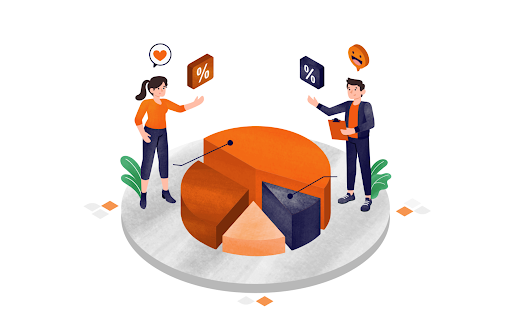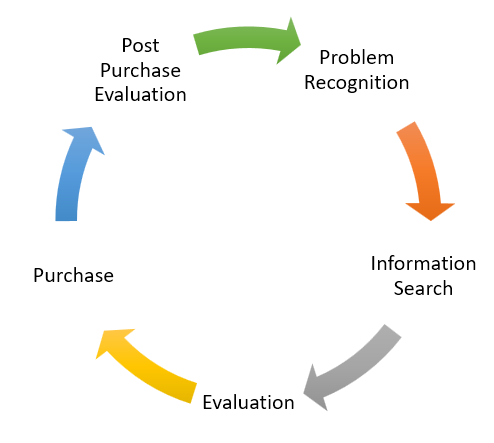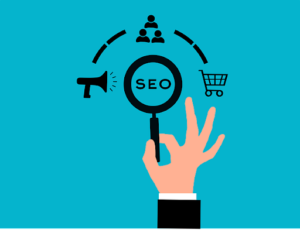What is Behavioral Segmentation and 7 Examples of Behavioral Segmentation
In today’s hyper-connected and data-driven world—understanding your customers has become more crucial than ever before. More than a one-size-fits-all strategy is required as companies work to provide personalized experiences and tailored marketing strategies. This is where behavioral segmentation steps in paving the way for a deeper understanding of customer behavior and preferences.
– 10 mins

Marketing segmentation is an effective strategy that has always been a part of successful marketing campaigns. By grouping customers based on their needs and actions—businesses can efficiently address their problems and sell more products.
Behavioral segmentation categorizes customers into distinct groups based on their actions, habits, and behaviors. This strategy is powerful for businesses because it helps them analyze how customers interact with products, engage with brands, and make purchasing decisions. By doing so—companies will gain valuable insights that inform decision-making and improve customer experiences.
Let us walk you through the world of behavioral segmentation with some examples in this blog. But before we delve deeper, let us first understand what behavioral segmentation is and why it is important.
Understanding behavioral segmentation
Behavioral segmentation is a marketing strategy that segments a target market into distinct groups based on their behaviors, actions, and consumption patterns. Rather than focusing on demographics or location, this segmentation method acknowledges that consumers’ purchasing decisions and behaviors are impacted by their unique requirements, preferences, and attitudes.
Through behavioral segmentation—customers are separated based on the ways in which they engage with a business. As the name implies, this type of segmentation examines customer behavioral characteristics, such as their familiarity with, attitude towards, usage of, preferences for, or reactions to a certain good, service, campaign, or brand.
Customers might be categorized into these groups based on:
- Their behavior when using your product or service
- Their perception of your product, brand, or service
- Their general familiarity with your brand and its products
- Their spending habits, such as their preference for making purchases exclusively on special days like holidays or birthdays, etc.
It’s vital to note that it doesn’t exist independently from other segmentation types. Characteristics such as a customer’s age, gender, location, income, and occupation frequently correlate with behavioral data. This means that behavioral data can often be used to confirm certain conclusions about other segmentation data.
Behavioral segmentation aims to:
- Recognise and respond to the distinct demands and preferences of various client groups
- Make your product or service specific to their requirements and wants
- Look for ways to improve the buying process
- Determine how valuable they may be to your company
- Create a clever marketing plan to increase and broaden your consumer base.
Why is behavioral segmentation so important?
Businesses should start using behavioral segmentation as part of their marketing strategies for several compelling reasons. Here are some key benefits:
1. Provides personalized experiences
Knowing your target market’s needs, wants, and demands will help you create the perfect product or marketing campaign. To achieve this—you must know how to target different customer groups with unique offers through their preferred channels and at the appropriate time. Personalizing your approach will allow you to nurture them further along their buying journey.
2. Assists in identifying your most engaged users
You can improve everything from your operations to your marketing strategy by understanding your most lucrative customers and what motivates them. The most engaged customers are the individuals who consistently check your emails, click on your social media postings, engage with your instagram handle, and are the first to express interest in your newest items.
3. Helps predict patterns
By analyzing behavioral data, we can predict how customers will behave in the future. We can also use historical behavioral patterns to influence future outcomes.
4. Assists in saving your money
You may send your target market the appropriate campaign by using behavioral segmentation. As a result—you won’t need to target a broad audience and can focus on the one that is most similar to your target market, which will lower the cost of your marketing initiatives, this is where focusing on smaller niche can be highly effective. It doesn’t make sense to waste money on an audience that was never yours.
5. Builds brand loyalty
Customers will feel good about your company since you stand out from the competition when they aren’t inundated with pointless advertisements or communications. They are more inclined to interact with the material that is carefully sent to them and is closest to their requirements.
6. Monitors performance
Businesses can anticipate their health and assess their success against the targets they set for themselves by tracking client behavior patterns and changes in segments over time.

7 Behavioral segmentation examples to help you grow your business
Behavioral segmentation may provide remarkable results when applied correctly converting previously cold leads or customers into freshly engaged and kept ones.
Here are some examples of the most precise and successful behavioral segmentation from real-world settings.

1. Purchasing behavior
Consider segmenting your clients depending on their purchase behavior if you want to learn more about their decision-making process. Purchase behavior segmentation examines how customers behave differently throughout the purchasing decision-making process.
Most businesses use purchase, usage, and consumption data to predict demand. Segmenting clients based on their purchase behavior, on the other hand, helps you determine when your marketing will be most effective since it allows you to learn the following:
- How customers approach buying decisions
- The purchase process’s complexity
- The role of the client in the purchase process
- Obstacles on the route to acquisition
- Which behaviors are the most and least predictive of purchasing decisions?
Purchasing behavior may be divided into four categories:
Habitual buying behavior—When making a purchase that takes little thought, the supplied product is similar between brands and largely comes down to personal choice. For instance, unbiased consumers might not notice much of a difference between Coke and Pepsi. Some individuals, nevertheless, would never favor one over the other.
Complex buying behavior—It usually happens while purchasing high-involvement or expensive products or services, such as a vehicle, home, or vacation package. Complex purchase behavior necessitates significant study, alternative comparison, feature and benefit evaluation, and consideration of personal wants and preferences, and frequently includes numerous influencers or decision-makers.
For example, if someone is picking between two great brands, that selection probably has a lot of bearing; it’s complicated).
Dissonance-reducing buying behavior—When a buyer is considering a sizable purchase, the differences between the comparable items supplied by several companies are not very great. For instance, a buyer could base their choice on pricing rather than the quality of the product when buying a new bedroom set.
Variety-seeking buying behavior—when a buyer isn’t highly engaged in the purchase process, yet there is still a distinction between the products other companies give. For instance, a user of Dove shampoo could occasionally switch to Suave. The user might persist with it if she enjoys it—otherwise, it won’t matter.
The majority of consumers fit into one of these groups At some time in their life. Their shopping habits mostly influence their categorization but also rely on the goods they buy. You may choose the ideal approach to promote your goods or services to them by knowing how these two entities interact.

2. Occasion/timing purchasing
This aspect of behavioral segmentation takes a customer’s life stage, time of year, or day into account when determining whether to make a purchase. Booking a hotel for New Year’s Eve is one of those universal events. While other choices are more private, like subscribing to a monthly gourmet spice box loaded with pricey, elusive herbs and spices, they can help you stay on top of your cuisine.
On the other hand, occasion-based segmentation is a popular segmentation technique. In this, the decision to purchase is discussed. Look through a few of the emails you get by going to your inbox. In order to encourage individuals to place weekend orders, your preferred delivery provider could send out emails with flash sales or discounts on Fridays.
Marketers can customize their strategies by understanding the timing and reasons behind consumers’ purchasing decisions. This approach acknowledges that consumer behavior changes based on special occasions like holidays, birthdays, anniversaries, or seasonal events.

3. Customer loyalty
Loyalty is one of the most crucial behavioral segmentation factors. Users who behave loyalty towards your company should not be disregarded. Customer loyalty is closely related to several of the other behavioral subsets, including usage, timing, and purchase behavior. However, regular consumers always need the products or services you provide, whereas devoted customers frequently use your goods or services.
Finding your most loyal customers and maintaining them as long-term clients generates ongoing revenue and is more affordable than finding new ones. Think about creating loyalty programmes for these customers and use their advocacy to promote the business or product. Their continuing support may be used to draw attention to the quality of your products and services offered and to attract new customers.
Customer loyalty behavioral segmentation may provide insightful responses to crucial problems like:
- Which critical actions encourage loyalty along the consumer journey?
- Who among your consumers would benefit most from loyalty and advocacy programmes?
- How can you satisfy your most devoted customers?
- How would you get the most out of your most devoted customers?

4. Benefits sought
When it comes to behavioral segmentation, another key factor is the specific benefits that customers are looking for in their experience. When researching a product or service, customers’ actions might provide important information about which features, advantages, applications, or issues are most relevant to them. And these major benefits motivate clients when they place a higher value on them than other perks.
Let’s take skincare as an example to help you grasp the concept better. People purchase skincare products for a multitude of reasons.
Knowing what benefits each user seeks from your product or service is important to provide better service.
Here are some examples of segmenting users based on their preferences for different benefits.
- Oily skin solution
- Mild fragrance
- Dark circles removal
- Non-irritating ingredients
- Price
This implies that two prospects might have the same demographic makeup but very different values regarding the features and perks that are most significant to them.

5. Customer journey stages
In behavioral segmentation, the buyer journey stage refers to the different phases or steps a consumer goes through when purchasing. It is a way to understand and categorize customers based on their behaviors and actions at various stages of the buying process.
The buyer journey typically consists of several stages, which may vary depending on the specific model or framework used.
However, a commonly recognized buyer journey includes the following stages:
- Awareness—This is the initial stage where the consumer becomes aware of a need or a problem. They start researching and exploring possible solutions or options.
- Consideration—In this stage, the consumer evaluates different alternatives and compares them based on various factors such as features, benefits, pricing, and reviews. They are actively considering different options and narrowing down their choices.
- Decision—At this stage, the consumer has a shortlist of options and is ready to make a decision. They may compare final details, seek additional information, and may be influenced by factors like discounts, incentives, or recommendations.
- Purchase—The consumer makes the final purchase decision and completes the transaction. This stage is characterized by the actual exchange of money or commitment to the chosen product or service.
- Post-purchase—The consumer evaluates their decision and experiences the product or service after the purchase. This stage is important for building customer satisfaction, loyalty, and advocacy. Positive experiences may lead to repeat purchases or recommendations to others, while negative experiences may result in dissatisfaction or negative word-of-mouth.
It might be difficult to pinpoint a client’s specific position in the customer journey. Customers may be divided into groups according to where they are in their journeys, and this can highlight any pain spots or reasons why a client doesn’t take the required action. For instance, it indicates a supply issue if the retailers constantly run out of merchandise.

6. Usage behavior
You can weed out the most devoted clients by looking at usage behavior. This parameter considers these factors:
- How frequently are your current clients using your products and services?
- What do they do with it?
- Which features do they most frequently use?
- Can multiple users use the same account?
- How long do they typically spend utilizing these features?
Usage-based segments include:
Heavy users—Your most devoted and engaged consumers who make the most frequent purchases and utilize your product or service the longest
Medium users—Clients who occasionally use or buy your products but not very often (typically on a time- or event-based basis)
Light users—Clients that utilize or make purchases significantly less frequently than other clients, occasionally even only once
You may transform your light users into medium and heavy users by segmenting your consumer base and focusing on the appropriate marketing methods for each. Freebies, engaging material, and birthday delights like a free present are a few tried-and-true strategies.
7. Brand interactions
Brand interactions encompass a wide range of activities, such as website visits, social media engagement, email responses, customer service interactions, and purchases. These interactions provide a wealth of data that will be used to customize marketing strategies and create personalized experiences for different segments.
This component entails researching consumer behavior across all of your brand’s channels, including online and physical ones. Additionally it reveals how involved a consumer is with your brand. Consider the brand Disney, which encompasses everything from movies to themed shops, amusement parks, merchandise, and vacations.

Wrapping up
Behavioral segmentation is a valuable tool for determining why a consumer chooses to purchase your product or service. This extra layer of information complements your demographic and regional segmentation enabling you to find new marketing approaches specifically targeted to your target market. You may improve consumer engagement, generate conversions, increase traffic and have more success in today’s cutthroat market by focusing your marketing efforts on certain behavioral categories. When used with one of the techniques above and using social listening you can acheive data trends and insights that you would not have seen otherwise.

Surrinder Pandita is a content writer at RankHandy. He has more than 6 years of experience writing for the marketing, HR, and business sectors and aims to provide high-quality content.





